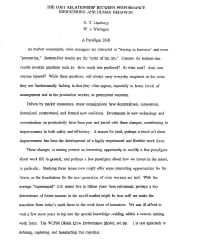Mining Publication: The Cost Relationship Between Performance Engineering and Human Behavior
Original creation date: January 1996
Authors: GT Lineberry, WJ Wiehagen
NIOSHTIC2 Number: 20022761
Trans Soc Min Metall Explor 1996 Jan; 298:319-326
Use of a face production simulator, such as CONSIM, in conjunction with an empirically-based method for successively improving work crew performance, such as the WCPM, can help identify and rank cycle elements for implementation of intervention strategies. This, in turn, can help human resource developers better target groups of tasks and subtasks as candidates for improved training or coaching, for job/equipment/condition modification, or for changes in management practices/policies. The net result if the acquisition of an ability to offer more specific guidelines for human resource development at the mine site- guidelines that are based on empirical evidence and meaningful analysis of performance metrics. Even pure "market economists," tempted always to seek technology and human operators that "run faster" at "less cost," might now consider investments that empower workers to "run smarter." Moreover, use of COMSIM has shown, by example, how common operating parameters (e.g., payload, tram rate) can be used as cost-conscious indicators of performance variability and therefore targeted for performance improvement. This field trial of the WCPM affirms the congruency between production and operator training by providing a unique cost linkage between performance engineering and human behavior.

NIOSHTIC2 Number: 20022761
Trans Soc Min Metall Explor 1996 Jan; 298:319-326
- The Availability of Primary Copper in Market Economy Countries: A Minerals Availability Appraisal
- CFD Analysis of Mine Fire Smoke Spread and Reverse Flow Conditions
- Methane Emission Rate Studies in a Central Pennsylvania Mine
- Methane Emission Rate Studies in a Northern West Virginia Mine
- Methane Migration Characteristics of the Pocahontas No. 3 Coalbed
- Nature and Cost of Low Back Pain
- Operationalizing Normal Accident Theory for Safety-Related Computer Systems
- Reservoir Engineering Considerations for Coal Seam Degasification and Methane Control in Underground Mines
- Thermal Stability of ANFO Made with Recycled Oil
- Torso Flexion Loads and Fatigue Failure Mode of Human Lumbosacral Motion Segments